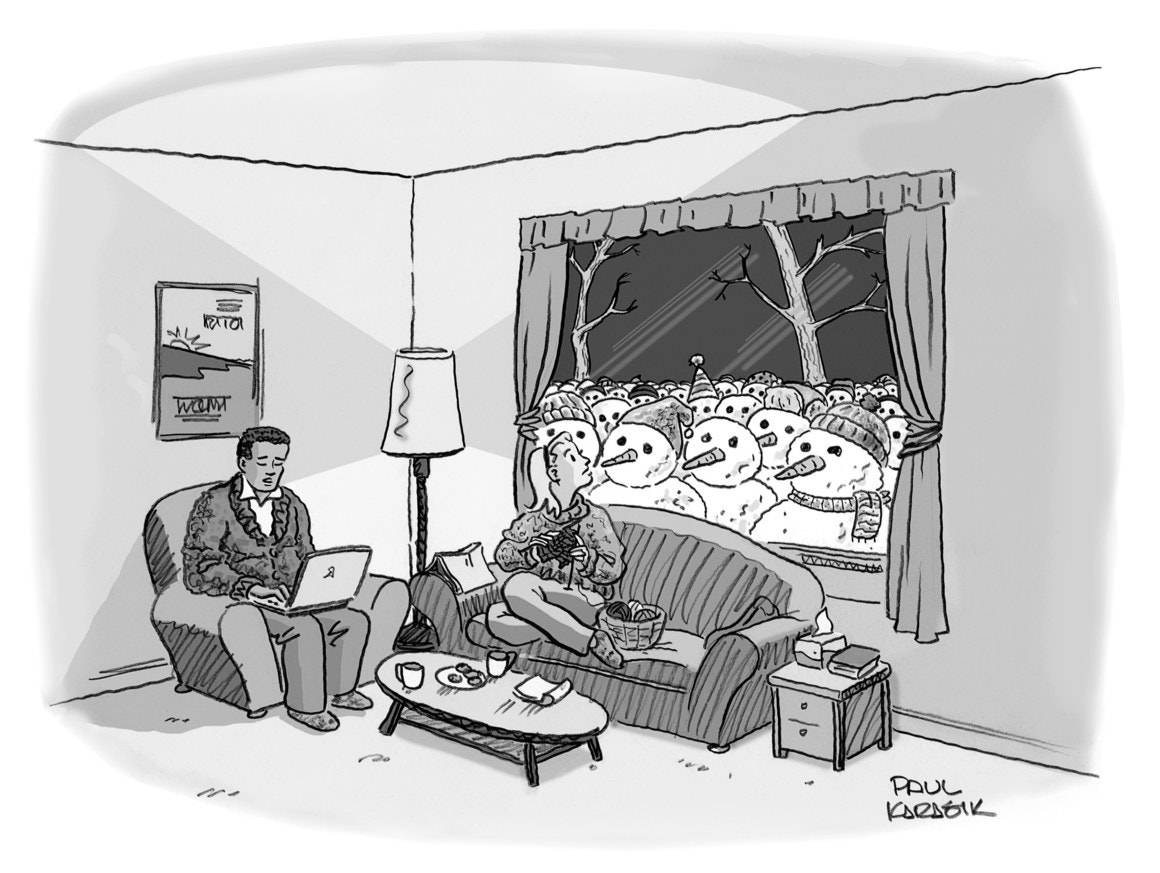Scans of three vintage New Year cartoons come to us courtesy of Dick Buchanan's Cartoon Clip Files. Each of the three cartoonists represented here was eventually to become a major New Yorker contributor, but at the time these were published George Booth and Gahan Wilson were still years away from having their first cartoons accepted by the magazine. Robert Weber, though, had been in the New Yorker for a couple of years at the time the cartoon of his shown here was published.
Dick writes that George Booth's silhouette art was published as a "spot drawing which appeared on the last page of the magazine. This page included jokes, humorous verse (what ever happened to that?) and two cartoons. Booth did these spots for, I think, 3 years—1953 to 1955. Long ago I posted all 12 from 1953 [at] Mike Lynch [Cartoons]. Have yet to uncover enough from 1954 & 1955."
Dick has posted the following Gahan Wilson cartoon to Mike Lynch Cartoons not once but twice now. Still, it's worth a third look to point out just how unconventional Wilson's approach was. The key here is to take special note of the date of publication and then the year of the calendars. Who else would even think of this?
Note: Boy, that Dick Buchanan sure knows his way around a scanner! This is Dick's fifty-first contribution to Attempted Bloggery. One more and I'll finally be playing with a full deck. Dick, of course, maintains the matchless Dick Buchanan Cartoon Clip Files. He also regularly contributes to Mike Lynch Cartoons, most recently a post entitled "From the Dick Buchanan Files: All In Fun: Gag Cartoons 1949 - 1968." Me, I just can't double up on colons in a post title like that.
By the way, you can find George Booth's aforementioned 1953 silhouette gags at "1953 George Booth Drawings for American Legion Magazine." It's all there in black and white.
As mentioned above, the Gahan Wilson calendar cartoon appeared twice, both in "Dick Buchanan's Cartoon Files: Gahan Wilson: Early Gag Cartoons 1954 - 1964" and in "Gahan WIlson 1930 - 2019."
Quick Links to the Attempted Bloggery Archives:
Happy New Year!
George Booth
Gahan Wilson
Robert Weber
Collier's
Look Magazine
Dick Buchanan
Attempted Bloggery's Auld Index
Dick writes that George Booth's silhouette art was published as a "spot drawing which appeared on the last page of the magazine. This page included jokes, humorous verse (what ever happened to that?) and two cartoons. Booth did these spots for, I think, 3 years—1953 to 1955. Long ago I posted all 12 from 1953 [at] Mike Lynch [Cartoons]. Have yet to uncover enough from 1954 & 1955."
 |
George Booth
The American Legion Magazine
January 1954, page 64
Scan by Dick Buchanan
|
Dick has posted the following Gahan Wilson cartoon to Mike Lynch Cartoons not once but twice now. Still, it's worth a third look to point out just how unconventional Wilson's approach was. The key here is to take special note of the date of publication and then the year of the calendars. Who else would even think of this?
 |
| Gahan Wilson Collier's, January 7, 1955
Scan by Dick Buchanan
|
Finally, Robert Weber's cartoon has the look of a gag created specifically for the New Yorker but very likely rejected by the magazine, perhaps because the gag is just a little bit forced. Anyway, in this era cartoons were published in a great many venues and cartoonists could peddle their rejects to other downstream magazines and those magazines that were selective enough and paid enough could give their readers humor very nearly on a par with that in the New Yorker. It was what we today would call a win-win for both the cartoonists and for the magazines. To quote the nostalgic Dick Buchanan, "Whatever happened to that?"
Note: Boy, that Dick Buchanan sure knows his way around a scanner! This is Dick's fifty-first contribution to Attempted Bloggery. One more and I'll finally be playing with a full deck. Dick, of course, maintains the matchless Dick Buchanan Cartoon Clip Files. He also regularly contributes to Mike Lynch Cartoons, most recently a post entitled "From the Dick Buchanan Files: All In Fun: Gag Cartoons 1949 - 1968." Me, I just can't double up on colons in a post title like that.
By the way, you can find George Booth's aforementioned 1953 silhouette gags at "1953 George Booth Drawings for American Legion Magazine." It's all there in black and white.
As mentioned above, the Gahan Wilson calendar cartoon appeared twice, both in "Dick Buchanan's Cartoon Files: Gahan Wilson: Early Gag Cartoons 1954 - 1964" and in "Gahan WIlson 1930 - 2019."
Quick Links to the Attempted Bloggery Archives:
Happy New Year!
George Booth
Gahan Wilson
Robert Weber
Collier's
Dick Buchanan
Attempted Bloggery's Auld Index
03123























































